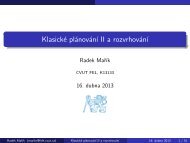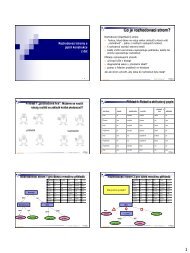and R
and R
and R
You also want an ePaper? Increase the reach of your titles
YUMPU automatically turns print PDFs into web optimized ePapers that Google loves.
Cardiac Rhythm Management<br />
Therapies, Products & Market<br />
Overview
CRM is Medtronic’s largest business<br />
Cardiac<br />
Surgery<br />
Spinal<br />
Neuro &<br />
Diabetes<br />
Vascular<br />
Western Europe Revenue: ∼$1.3 billion<br />
CRM
Cardiac Rhythm Management<br />
Businesses<br />
Bradyarrhythmia<br />
Atrial Fibrillation<br />
Monitors<br />
Cardiac<br />
Rhythm<br />
Management<br />
Tachyarrhythmia<br />
EP Systems<br />
Heart Failure
CRM’s businesses<br />
Physio<br />
Control<br />
Heart<br />
Failure<br />
Tachy<br />
Vitatron<br />
Western Europe Revenue: $650 million<br />
EP Systems<br />
Medtronic<br />
Brady
Cardiac Rhythm Management<br />
Provides:<br />
– Implantable Pulse Generators (IPG’s)<br />
– Implantable Cardioverter Defibrillators (ICD’s)<br />
– Programmers (+Patient Management Tools)<br />
– Leads<br />
– Monitors<br />
– External Pacing Systems<br />
– Electrophysiology Mapping <strong>and</strong> Ablation Systems<br />
For: Slow, Fast, Irregular <strong>and</strong> Failing Hearts<br />
– Electrical <strong>and</strong> Mechanical indications
Cardiac Rhythm Management<br />
Strategies<br />
Exp<strong>and</strong>ing Markets<br />
Apply combinations<br />
of core Medtronic<br />
technology to address<br />
disease states as they<br />
exist alone, as<br />
co-morbidities <strong>and</strong><br />
as they progress<br />
750,000+<br />
$2.4 Billion<br />
90,000–400,000<br />
Potential Patient Population $??<br />
Current Market Size<br />
Brady<br />
250,000–<br />
400,000<br />
$??<br />
AF HF<br />
Tachy<br />
150,000–<br />
350,000<br />
$1.1 Billion
European IPG Implant Rates
European ICD Implant Rates
Bradyarrhythmia Management
The Clinical Problem
Who are the traditional patients<br />
requiring permanent pacing therapy?<br />
People with bradyarrhythmias<br />
Definition: bradyarrhythmia<br />
– A slow heart rate
Bradyarrhythmias can result in<br />
low cardiac output...<br />
Then<br />
CO = HR x SV<br />
↓<br />
↓ (Tachyarrhythmias)
…which can cause transient or<br />
permanent symptoms.<br />
Syncope (fainting)<br />
Pre-syncope<br />
Dizziness<br />
Fatigue<br />
Palpitations<br />
Mental confusion<br />
Exercise intolerance<br />
Seizure
If the symptoms include Syncope -<br />
What is Syncope?<br />
Syncope<br />
– Sudden transient loss of<br />
consciousness<br />
Associated with loss of postural<br />
tone<br />
Due to abrupt reduction or loss of<br />
cerebral perfusion
The clinical impact can be significant.<br />
Reduction in QoL<br />
Falls <strong>and</strong> associated injuries<br />
Potential emergence of dangerous<br />
ventricular tachyarrhythmias that result<br />
from bradycardia
1 Linzer M. J Clinical Epidemiol. 1991;44:1037-1043.<br />
2 Linzer M, et al. J Gen Intern Med. 1994;9:181-186.<br />
Recurrent, Unexplained Syncope:<br />
Quality Of Life Impact<br />
Area of<br />
Impairment<br />
Proportion<br />
Impaired<br />
Anxiety/depression 73% 1<br />
Daily life activities 71% 2<br />
Driving 60% 2<br />
Physical activities 56% 2<br />
Employment 37% 2<br />
Sexual function 30% 2<br />
Relationships with<br />
family, spouse, friends 28-30% 2
Magnitude of the Problem<br />
Syncope is a common clinical problem with<br />
significant costs<br />
– Approximately 750,000 new patients per year<br />
in Europe (0.2% of the population)<br />
– 1-6% of hospital admissions 2-4<br />
– 3% of emergency room visits<br />
per year 5<br />
1. National Disease <strong>and</strong> Therapeutic Index, IMS America, Syncope <strong>and</strong> Collapse ISC#780.2,<br />
Jan 1997-Dec 1997.<br />
2. Gendelman HE, et al. NY State J Med. 1983;83:1161-1165.<br />
3. Kapoor W, Med. 1990;69:160-175.<br />
4. Eagle K, et al. Yale J Biol <strong>and</strong> Med. 1983;56:1-8.<br />
5. Day SC, et al. Am J of Med. 1982; 78:15-23.
The problem can originate in the<br />
sinus node ..<br />
P P P P<br />
P<br />
R R R R<br />
R<br />
P<br />
R
…or in the conduction system<br />
P P P P<br />
R R R R<br />
P P P P P<br />
R R
There can be several causes of<br />
the symptoms<br />
Cardiac<br />
– Structural heart<br />
diseases<br />
– Obstruction to flow<br />
– Pump Failure<br />
– Cardiac Tamponade<br />
– Aortic dissection<br />
– Arrhythmias<br />
– Bradyarrhythmias<br />
– Tachyarrhythmias<br />
Non-cardiac<br />
– Reflex mechanisms<br />
– Orthostatic<br />
hypotension<br />
– Psychogenic
Goal: Document correlation of<br />
symptoms to the arrhythmia<br />
P P P P P<br />
R R
Cardiac Arrest<br />
Arrhythmia Hospitalisation<br />
VF<br />
VT<br />
AFib<br />
AFlut<br />
Junctional<br />
Prem. beats<br />
Sick Sinus<br />
Cond. Disease<br />
Unspecified
The clinician has various tools to<br />
diagnose cardiac arrhythmias<br />
Patient history<br />
Physical exam<br />
12-lead ECG<br />
Holter monitor<br />
Event recorder<br />
EP tests<br />
Implantable Loop Recorder - Reveal +
What is the Implantable<br />
Loop Recorder (ILR)?<br />
Useful for patients with infrequent symptoms who remain<br />
undiagnosed after the initial work-up<br />
Minimally invasive, leadless cardiac<br />
event recorder<br />
Provides up to 14 months of continuous monitoring<br />
Stores up to 42 minutes of ECG
Patient Selection Criteria<br />
Patients who experience transient symptoms<br />
such as difficult-to-diagnose syncope<br />
– Symptoms are infrequent<br />
– Symptoms are recurrent<br />
– Symptoms are unexplained
Why the ILR ?<br />
The less frequent the symptoms are...<br />
– The less likely conventional monitors will yield a<br />
diagnosis<br />
– The more testing you’ll do<br />
– The more costly your attempt to diagnose<br />
becomes<br />
– The more frustrated the patient <strong>and</strong> physician<br />
become<br />
Reveal ® ILR may break the cycle of<br />
diagnostic testing
1 Klein GJ, et al. Circulation 1995; 92:1332-1335.<br />
Syncope Diagnosis<br />
Diagnostic “Gold St<strong>and</strong>ard” 1<br />
– An ECG strip recorded during a<br />
spontaneous syncopal episode, i.e.,<br />
symptom-rhythm correlation<br />
– Non-presumptive diagnosis of<br />
arrhythmic cause, or<br />
– Definitive rule-out of arrhythmic cause
Seizures & Syncope: A Case Example<br />
After 15 years of having treatment-resistant<br />
epilepsy, a man received a Reveal ®<br />
implant1 Following a seizure, the Reveal<br />
showed a 36 second pause<br />
Zaidi, P. Clough, G. Mawer, A. Fitzpatrick. “Accurate Diagnosis of Convulsive Syncope:<br />
le of an Implantable Subcutaneous ECG Monitor.” Seizure 1999; 8:184-186.<br />
After receiving a pacemaker,<br />
the episodes stopped
If a correlation is found<br />
between symptoms <strong>and</strong> ECG<br />
changes..
Is there a Bradycardia or a<br />
Tachycardia ?<br />
Is the cause reversible ?<br />
Will drug therapy affect the cause ?<br />
If the patient needs pacing…...<br />
– temporary or permanent ?
Temporary pacemaker<br />
Lead (s) connect<br />
the pacemaker to<br />
the cardiac<br />
chamber(s)
If the patient needs a<br />
Permanent Pacemaker...<br />
What does a pacemaker do?
If the patient needs a<br />
Permanent Pacemaker...<br />
It acts as a replacement for that part of the<br />
conduction system that is not functioning<br />
appropriately.
What is a Permanent<br />
Pacemaker?<br />
A Pacemaker System consists of a<br />
Pulse Generator plus Lead (s)
What is a Pacemaker?
Relationship of the Pulse Generator & Lead
What is a Pacemaker?
What is a Pacemaker?
Anatomy of a Pacemaker<br />
Connector<br />
Hybrid<br />
Battery<br />
Resistors<br />
Atrial connector<br />
Ventricular connector<br />
Defibrillation protection<br />
Output capacitors<br />
Clock<br />
Reed (Magnet) switch<br />
Telemetry antenna
What is a Lead?<br />
Tip Electrode Conductor<br />
Insulation Connector Pin
Leads Are Insulated Wires That:<br />
Deliver electrical<br />
impulses from the<br />
pulse generator to<br />
the heart<br />
Sense cardiac<br />
depolarisations
Leads are passed into the heart via veins:
Leads<br />
Bradycardia Pacing Products<br />
CapSure,<br />
CapSure SP,<br />
<strong>and</strong> CapSure Z
Bradycardia Pacing Products<br />
CapSure Z <strong>and</strong> CapSureFix Pacing Leads
Bradycardia Pacing Products<br />
Medtronic.Kappa Series<br />
Medtronic.Kappa 400<br />
Dual Sensor Pacemakers<br />
Medtronic.Kappa 700<br />
Automatic Family<br />
of Pacemakers<br />
Medtronic.Kappa 900<br />
Automatic Family<br />
of Pacemakers
Rate Responsive Pacing<br />
When the need for oxygenated blood increases, the<br />
pacemaker ensures that the heart rate increases to<br />
provide additional cardiac output
25 Years of Technology Growth<br />
1975<br />
Xyrel Kappa 700<br />
Fixed Rate,<br />
Synchronous<br />
Pacing<br />
Transistor Count: 35<br />
User’s Manual 20 pages<br />
No Programming<br />
Available<br />
Xyrel in 1998<br />
Technology<br />
Fully programmable,<br />
physiologic pacing,<br />
extensive diagnostics<br />
Transistor Count: 900,000<br />
User’s Manual 670 pages<br />
No Programming<br />
Necessary<br />
1998
Vitatron Products
DA+: World’s First Digital<br />
Pacemaker<br />
First clinical implant of the new vitatron C-series<br />
pacemaker worldwide<br />
Arnhem, The Netherl<strong>and</strong>s, 31 January, 2003 –<br />
Today, Vitatron announced the start of an international<br />
multi-center clinical device study evaluating its new<br />
Vitatron C-series: the first fully digital pacemaker in the<br />
world. The first implant took place at the University Clinic<br />
in Graz, Austria, by Professor Dr. K.H. Tscheliessnigg <strong>and</strong><br />
his team.
How do we know what a<br />
pacemaker has been doing?
How do we know what a<br />
pacemaker has been doing?<br />
Traditionally, the patient comes<br />
to a pacing clinic...
The pacemaker is interrogated<br />
using a Programmer<br />
2090 9790
But with Remote View..<br />
The customer requests help from<br />
the remote consultant/MDT<br />
– The consultant/MDT, via their PC, calls the<br />
CareLink Programmer<br />
A Remote Session
Tachyarrhythmia Management
NSR <strong>and</strong> VF
Today:<br />
Physio-Control<br />
Sudden Cardiac Death is<br />
the most common cause<br />
of death in the U.S.<br />
Sudden Cardiac Arrests<br />
in the U.S. annually:<br />
400,000<br />
Less than 5% survive
Patients (000's) in US<br />
1,000<br />
800<br />
600<br />
400<br />
200<br />
0<br />
FY91<br />
FY92<br />
MADIT<br />
SCD<br />
FY93<br />
ICD Implant Potential<br />
AVID<br />
FY94<br />
MUSTT<br />
FY95<br />
FY96<br />
FY97<br />
FY98<br />
MADIT II<br />
FY99<br />
FY00<br />
FY01<br />
FY02<br />
SCD-HefT<br />
FY03<br />
FY04<br />
FY05<br />
FY06<br />
FY07<br />
Potential<br />
Implants
ICDs are more effective than<br />
drugs
Defibrillation Systems Products<br />
Leads
Defibrillation Systems Products<br />
6947
A Decade of Change in ICD<br />
Technology<br />
1989 - Model 7216A<br />
209 cc; 281 g<br />
34 Joule output<br />
ATP<br />
1993 - Model 7219C<br />
80 cc; 129 g<br />
34 Joule output<br />
Active Can ®<br />
1996 - Model 7223Cx<br />
54 cc; 97 g<br />
30 Joule output<br />
EGM-width
The World’s Most Advanced<br />
Full-Featured Implantable Defibrillator<br />
2001 – Marquis DR<br />
36 cc; 75 g<br />
30 Joule output<br />
painless lead<br />
impedance<br />
patient alert<br />
rate responsive pacing<br />
advanced detection<br />
criteria<br />
Automatic P- <strong>and</strong> RR-<br />
wave measurements<br />
Cardiac compass
Therapies Provided by Today’s<br />
Dual-Chamber ICD’s<br />
Atrium<br />
ATP<br />
Low-energy<br />
cardioversion<br />
Defibrillation<br />
Ventricle<br />
ATP<br />
Low-energy<br />
cardioversion<br />
Defibrillation<br />
Atrium & Ventricle<br />
Bradycardia sensing<br />
Bradycardia pacing
Atrial Fibrillation<br />
A Business Overview
What is Atrial Fibrillation<br />
First described in 17th century<br />
by Sir William Harvey 1<br />
James Mackenzie - ‘pulsus<br />
irregularis perpetus’ in 1903<br />
Chaotic electrical activity in the<br />
atrium with irregular <strong>and</strong> fast<br />
ventricular response<br />
Most common sustained<br />
cardiac arrhythmia<br />
1. Harvey W. Movement of the Heart <strong>and</strong> Blood in Animals. Translated by K.J. Franklin. Oxfortd:Blackwell, 1957
Clinical Impact of Atrial Fibrillation<br />
Stroke<br />
CHF<br />
Embolism<br />
Palpitations<br />
Dyspnea<br />
Angina<br />
Exercise intolerance<br />
Fatigue<br />
Vertigo
Incidence & Prevalence of AF<br />
Ca. 3.3 Mio patient<br />
suffer from AF<br />
today<br />
Ca. 432’000 new<br />
AF patients each<br />
year
Cardiac Arrest<br />
Arrhythmia Hospitalisation<br />
VF<br />
VT<br />
AFib<br />
AFlut<br />
Junctional<br />
Prem. beats<br />
Sick Sinus<br />
Cond. Disease<br />
Unspecified
Antiarrhythmic Drug Treatment<br />
% Patients<br />
free of AF<br />
recurrence<br />
100<br />
80<br />
60<br />
40<br />
20<br />
Suttorp, et al; Am J Cardiol 1993; 71:710-13.<br />
n = 145<br />
12 24 36 48<br />
Follow-up, months
Product Strategy for Atrial Fibrillation<br />
High Energy Device<br />
Model 7262<br />
Ablation Tools<br />
Amazr & Maze Pen<br />
Low Energy Devices<br />
AT500 & Selection
Medtronic GEM III AT<br />
Second generation high energy<br />
atrial & ventricular<br />
Arrhythmia Management Device<br />
Atrial prevention<br />
Atrial & ventricular pace therapies<br />
Atrial & ventricular shock termination<br />
39 cc, 77 grams, 13.5 mm<br />
30 Joules
Medtronic AT500<br />
First low-energy atrial<br />
Arrhythmia Management Device<br />
Extensive monitoring for atrial<br />
arrhythmias<br />
Arrhythmia prevention algorithms<br />
Atrial anti-tachy pacing & 50 Hz burst<br />
Dual-chamber, rate responsive pacing<br />
15cc, less than 30g<br />
5 years nominal longevity
DiagnoseAF<br />
Dual Chamber DDDR<br />
Dual Sensor<br />
•Beat-to-Beat ModeSwitching<br />
•AF focused diagnostics<br />
•Save-to-disk<br />
-> AFdiscover<br />
Fixed:<br />
Selection 900E AF1.0<br />
Vitatron Products<br />
PreventAF<br />
+<br />
4 AF preventive pacing<br />
Algorithms:<br />
• Pace Conditioning<br />
• PAC Suppression<br />
• Post PAC response<br />
• Post Exercise Response<br />
Fixed:<br />
Selection 900E AF2.0<br />
Selection 9000<br />
+<br />
Upgradeability:<br />
AF3.0<br />
Upgradeable:<br />
PreventAF
Diagnostic catheters<br />
EP-Systems<br />
Radio Frequency (RF) Ablation catheters<br />
RF Generators<br />
Catheter Navigation Technology
SA<br />
Diagnostic Catheters<br />
a wide range for electro-physiologic investigations<br />
RA CS<br />
HIS<br />
RV<br />
Torqr 5-6 French<br />
Torqr CS<br />
J5<br />
Soloist<br />
Steerable cath’s<br />
Stable Mapr<br />
Sheaths
HRA<br />
HIS<br />
CS<br />
Catheters in the heart allow to observe the ECG together with<br />
local intracardiac egm’s from inside the heart.<br />
These recordings allow diagnosis of arrhythmias<br />
What is the mechanism? How does it work? Is the arrhythmia life<br />
threateting?<br />
What is the best treatment? Can we cure it by RF-ablation?<br />
Or ICD implant? Or?<br />
RV<br />
LV
RF Ablation<br />
Destruction of a distinct area in the heart to<br />
interrupt the re-entry circuit or take out the focus of<br />
a tachycardia<br />
This is done by local heating with High Frequency<br />
energy (RF energy)<br />
Curative therapy: no more need for medication or<br />
implantable devices after successful treatment<br />
Effective for most tachycardias <strong>and</strong> exp<strong>and</strong>ing
Arrhythmia Example<br />
AV Nodal Re-entry<br />
Tachycardia<br />
(AVNRT)-<br />
Most common<br />
form of SVT.<br />
An extra pathway<br />
exists in or next to<br />
the AV node.
RF Ablation Catheters<br />
Enhancr<br />
– steerable 7F<br />
Conductr<br />
– multi steerable 7F<br />
Marinr 5F<br />
– pediatric & geriatric<br />
Contactr<br />
– Atrial Flutter<br />
Amazr<br />
– long linear lesions (AF)<br />
Sprinklr<br />
– Saline cooled tip (VT)
RF Conductr ® Catheter<br />
Unique Multi-directional Tip Movement
Atakr II<br />
100 W RF Generator<br />
Low Energy Measurement<br />
(pre-ablation RF Therapy<br />
quality asessment)<br />
Up to 100W power<br />
Data communication<br />
with PC or Loca Lisa<br />
Easy Use<br />
Many safety features<br />
Multi programmable<br />
Prepared for<br />
saline cooled catheters<br />
Temperature or Power<br />
controled ablation<br />
therapies
Results<br />
Small lesions<br />
Distinct transition<br />
zones<br />
2 lesions at endocardium<br />
immediately post ablation
Indications for RF ablation<br />
<strong>and</strong> Success rate<br />
AVNRT<br />
Atrial Flutter<br />
AVRT (WPW syndrom)<br />
Focal arrhtymia (AT or VT)<br />
Other VT<br />
RVOT<br />
Atrial Fibrillation<br />
95%<br />
90%<br />
95%<br />
85%<br />
60-80%<br />
85%<br />
70-90%
y<br />
Loca Lisa<br />
a universal navigation tool for EP studies<br />
z<br />
x<br />
• 3 pairs of skin electrodes<br />
are in an x, y, z<br />
orientation around the<br />
heart<br />
• Three separate lowpower<br />
RF fields between<br />
electrodes create three<br />
orthogonal fields<br />
• Use the voltage at the<br />
catheter electrode to<br />
determine position of that<br />
catheter in 3D space
Heart Failure Management
Causes of Heart Failure<br />
Narrowed arteries<br />
Previous heart attack<br />
High systemic or pulmonary blood<br />
pressure<br />
Heart valve disease<br />
Infection or inflammation of heart<br />
muscle fibers
Heart Failure Classifications<br />
NYHA Class Status<br />
I No Physical<br />
Limitations<br />
II Slight Limitations<br />
III Marked Limitations<br />
IV Bed-ridden
Incidence <strong>and</strong> Prevalence<br />
22 million heart failure patients worldwide<br />
– (4.7 million in Europe)<br />
700,000 new cases each year<br />
– (418,000 in Europe)<br />
Most common cause of hospital admission<br />
over 65 years<br />
The only heart disease that is growing in<br />
occurrence<br />
$15B est. Annual cost Europe<br />
(2% of healthcare)
CRT is a Huge Opportunity<br />
50% reduction in in hospitalization rates<br />
77% fewer hospital days<br />
JAMA Feb 2003-<br />
51% reduction in in Mortality<br />
CARE HF Study –<br />
First European r<strong>and</strong>omized study to to look look at at CRT CRT on on<br />
survival, hospitalization <strong>and</strong> <strong>and</strong> economics
Heart Failure Management<br />
InSync III Bi-ventricular<br />
Cardiac Stimulator
Cardiac Venous Anatomy<br />
<br />
<br />
1. Lateral (marginal)<br />
cardiac vein<br />
2. Postero-lateral cardiac<br />
vein<br />
3. Posterior cardiac vein<br />
4. Middle cardiac vein<br />
5. Great cardiac vein
Left-heart Leads<br />
ATTAIN OTW
Medtronic CRM...
Common Software/Programmer<br />
Architecture


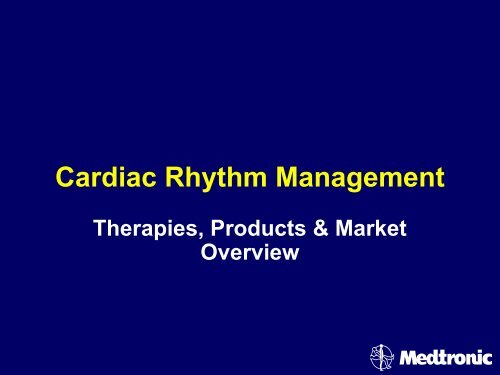
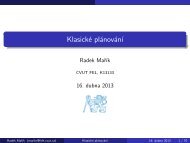
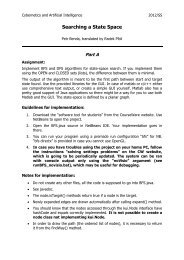

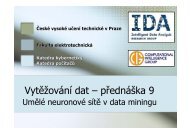
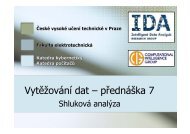
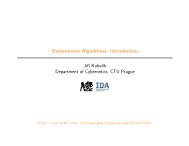
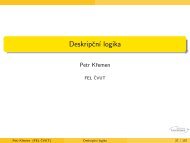


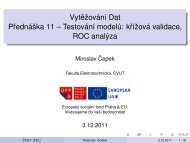
![RANSAC [Fischler, Bolles '81]](https://img.yumpu.com/17549294/1/190x143/ransac-fischler-bolles-81.jpg?quality=85)

